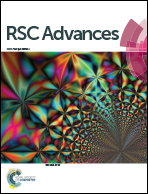Fabrication of morphology controlled graphene oxide-dye composite films at the air–water interface
Abstract
This study presents a facile route for preparing two-dimensional (2D) graphene oxide-based composite films using the Langmuir–Blodgett (LB) method. Graphene oxide-dye composites are formed with the incorporation of GO sheets and dye molecules (pyronin Y) at the air–water interface, since GO sheets are perfectly capable of forming a floating-layer at the air–water interface. Graphene oxide–pyronin Y (PyY@GO) composites are successfully assembled as highly ordered thin films over a glass substrate using the LB method. The surface pressure–area (π–A) isotherm studies reveal that pristine GO sheets and PyY@GO composites are capable of forming stable Langmuir films at the air–water interface. The limiting areas of pristine GO sheets and the composites are determined, and the area of pristine GO sheets are found to be larger than that found on PyY@GO composites. This observation clearly indicates the interaction of GO sheets with PyY molecules at the air–water interface, resulting in the formation of PyY@GO composites. Next, the floating layers of GO sheets and PyY@GO composites are successfully transferred to the glass substrate, using the LB method, as mono- and multi-layer films. Their LB films are characterized by SEM and UV-vis spectroscopy. SEM images reveal that the density of the GO sheets and PyY@GO composites on the substrate are tuned by changing the film deposition pressure and the number of layers.


 Please wait while we load your content...
Please wait while we load your content...